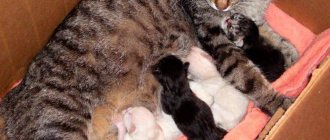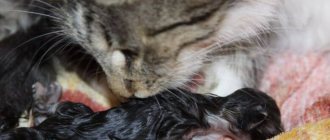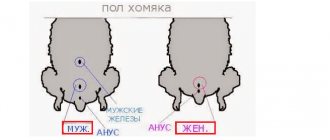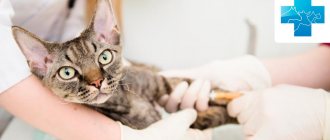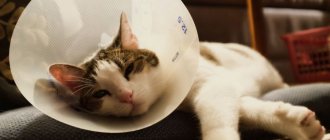Signs of labor in a cat
- Over the course of a day or three days, the temperature drops to 37 C.
Signs of labor in a cat - Over the course of a day or two, the cat manically tidies itself up and licks itself.
- The mucous membranes swell and acquire a red or pink tint.
- The skin in the nipple area notices an increased temperature, the mammary glands swell.
- The animal seeks solitude and refuses to “communicate.”
- Some time before giving birth, the female begins to have training contractions, she stretches out, hunches over, and may ask for help.
- Lack of appetite, only drinking is accepted.
- The main signs of labor beginning are noted in about a day. In a large number of cases, a mucus plug comes out of the cervix: it is a grayish clot with red streaks that protects the entrance to the uterus from infections and bacteria.
- There are movements in the pet’s stomach: the kittens, which were previously located chaotically in the womb, try to turn their heads down, towards the exit.
- The first contractions will be barely noticeable upon palpation; you can put your palm on your stomach and feel how it hardens from time to time. This is the uterus becoming toned and contracting.
- When the contractions are well palpable, the cat lies on its side or bends over and squats: it’s time to declare full combat readiness; kittens will begin to be born within an interval of five minutes to an hour.
What are the harbingers of feline birth?
A cat before giving birth
Usually, pregnancy and childbirth itself pass quite quickly in furry purrs. But still, certain observation will not hurt so as not to miss the process of delivery. About 14 days before birth, you can see what kind of harbingers of childbirth they are. The first sign can be attributed to the active movement of kittens in the stomach, regardless of their number, there is not enough room for them there and they are preparing to come out into the world soon, the main thing is that they are not. And for this you need to know when the mating took place.
Meanwhile, the expectant mother is already looking for a secluded place where the future family will be quiet and comfortable. Let's look at other signs of close labor:
- the cat actively licks its genitals and belly, its behavior becomes more and more restless, it rushes around the room in search of a secluded place;
- with the onset of contractions, breathing quickens and becomes heavier;
- if you measure the rectal temperature, its value may be around 37 ºC, everything is going according to plan, there is nothing to worry about;
- the genitals become swollen, you can even see discharge, light brown or pink, do not worry - this is the norm in this condition;
- colostrum arrives to the mammary glands, and this causes them to swell, which is visible visually;
- the animal may experience pain, causing it to meow loudly and try to hide, but this does not happen to everyone; some cats calmly endure the pain.
All these precursors can cause a cat to give birth in the very near future. You need to be prepared to accept babies.
How long does a cat's first birth last?
If this is your pet’s first birth and you have never delivered births to other cats, it is highly advisable that the process be carried out under the supervision of a specialist. If you have at least once carefully observed the process of the birth of kittens, you will be able to help your pet yourself. During the first birth, a cat may encounter problems such as a lack of understanding of what to do with the kittens after they appear, gnawing the umbilical cord, or separating the kitten from the bladder. Normally, labor for a primigravida may take from two to thirty-six hours.
Recommended reading:
How long does pregnancy last in cats?
What to do if the fetus is in the birth canal
If the fetus remains in the birth canal, then this situation is dangerous for the animal. This means that it is dead and will sooner or later begin to decompose. One possible consequence of this is the loss of the ability to give birth to kittens.
Important! If the necessary help is not provided in time, this can lead to the death of the pet.
The use of special veterinary drugs can provoke additional labor pains and contribute to the birth of the baby. For this purpose, administration of oxytocin at a dose of 0.3 mg can be used. This should only be done as recommended by a veterinarian.
When using this type of product, it is necessary to take into account the possible allergic reaction of the animal.
If the last kitten cannot be born, the cat needs urgent help from the owner
How long does it take for a normal birth?
The standard time for labor in a cat is 12-18 hours. This is the maximum break time between kittens. In the case when, 12 hours after the birth of the first baby, the second has not yet appeared, this is a reason to urgently run to the doctor. If, in general, childbirth takes more than 24 hours (from the first to the last kitten), this is also a pathology that requires immediate professional assistance in delivery.
There are many possibilities due to which the birth may not go as planned, with pathologies. This is the physiological structure of the animal's organs. Unlike humans, cats have a two-horned uterus; each of the two horns can contain kittens and, if they begin to move along the birth canal at the same time, they can easily get stuck.
In case of pathological birth, two days is the maximum period at which there is hope that the kittens are still alive.
Cat birth step by step
At the first stage of the birth process, the expectant mother will fidget restlessly in her nest, sometimes even beginning to cover its floor with her own fur. The appearance of slight trembling, rapid breathing, accelerated heartbeat, and milk secretion from the papillae are noted.
Typically, a cat gives birth to kittens within twenty-four hours, but if this is the first birth of a domestic cat, then the birth may take longer. The need to call a veterinarian arises when the process of contractions itself is very difficult. It will be much easier for a young cat to give birth the second time, and the process of giving birth to kittens will be much easier and faster.
At the second stage, the water begins to break, at which time the cat mainly lies on its tummy or back (in very rare cases, it can stand on its paws).
As soon as the kitten's head appears, you can detect it for up to 15 minutes (it is during this time that the kitten should be born). If within the allotted time the kitten was unable to come out, then it is necessary to urgently call a specialist who will stimulate the process of contractions and help with childbirth. Sometimes, due to the irresponsibility of the owners, cat births at home are fatal for the mother.
© shutterstock
Usually the cat herself frees newborn kittens from the amniotic sac and umbilical cord, but if she did not do this, then the owner needs to do it himself.
After the birth of a kitten, an afterbirth usually follows, one afterbirth per kitten. If the afterbirth remains inside the mother, this will lead to inflammatory processes in the genitals. The cat usually eats the afterbirth itself, sometimes this is accompanied by vomiting and digestive system upset (diarrhea).
The third stage of labor is relatively calm. This is the stage when the uterus is relaxed and there is a break between the birth of kittens.
Features of childbirth in a Scottish cat
Tarts stand out indicatively even in the process of harbingers of childbirth. In contrast to her usual calm behavior, she becomes aggressive and anxious. “Nests” vigorously, looking for a secluded corner for childbirth: digging through rubble of clothes, hiding in drawers, crawling under the sofa. Ideally, the owner should help create a place for the pet to give birth: a spacious box or drawer, covered with sterile diapers and equipped with a bowl of water. On the day of delivery, the cat begins to behave restlessly, chase the owner, and meow helplessly and pitifully.
Recommended reading:
When can you give a kitten away?
In about a day, the animal stops eating and drinks only water. If a cat walks around the apartment and meows loudly, most likely she is having contractions and experiencing pain. Dilated pupils and irregular breathing indicate that she is scared. The pet needs to be petted, calmed and returned to its nest. Most likely, repeatedly. A primiparous mother may ignore her kittens at first. This will continue until the production of the necessary hormones increases, she will not touch them. This is not something to be afraid of.
Cats: pregnancy, childbirth, feeding.
Pregnancy in cats lasts on average 65 days, but this period can normally vary from 58 to 68 days.
Many cats stop eating 24-48 hours before giving birth.
When the rectal temperature drops 1 degree above the cat's normal temperature, labor can be expected to begin within the next 12 to 36 hours. Usually we are talking about a temperature drop below 37.2C.
This period lasts from a couple of hours to a day (usually 6-12 hours). At this time, weak contractions of the uterus (contractions) begin. The cat may show restlessness, run from corner to corner, suddenly freeze, breathe with its mouth open, meow, urinate frequently, tremble, and dig the litter. There may be vomiting. At the end of this period, the cervix is fully dilated.
At this time, pushing occurs (intense contraction of the uterus and abdominal muscles), and the kitten is born. This period should last no longer than 30 minutes. If pushing continues for more than 30 minutes and no part of the kitten is visible, you should consult a doctor IMMEDIATELY.
Once part of the kitten has emerged, the entire kitten should be born within a few minutes. If more than 10 minutes have passed and the kitten has not yet been fully born, this is a reason for IMMEDIATE medical attention.
Kittens can be born head first or tail first - both are normal for cats. However, normally, in both cases, both front or both hind legs should appear along with the head or tail.
This is the period during which the placenta (afterbirth, place) comes out. Each kitten has its own placenta, and it can come out after each kitten, or several placentas after several kittens. It is advisable to count the number of delivered placentas. However, cats usually eat placentas immediately after they come out, so if you count fewer placentas than kittens, this does not mean that some placentas did not come out - perhaps the cat simply ate them and you did not notice it. Usually all placentas are delivered within a couple of hours after birth. In general, retained placenta is a very rare problem in cats.
There is no benefit to eating placentas. Moreover, cats that eat a lot of placentas during the birthing process often develop temporary diarrhea or vomiting.
The break between kittens is usually 20-60 minutes, but it can be 10 minutes or several hours. Sometimes the interval between the birth of kittens stretches to 4-6 or even 12-24 hours. This sometimes happens before the last one or two kittens. However, if more than 4-6 hours have passed and the cat is not giving birth, and you believe that she has more kittens in her uterus, you should consult a doctor.
Kittens are usually born in the membranes. These membranes should be immediately removed from the kitten's face to prevent it from suffocating. If the cat doesn't do it herself within a minute, then you should do it. These films are simply torn with your fingers.
After this, the kitten should either be licked by the mother or rubbed with a dry towel.
We suggest you read: What breeds of cats are fluffy?
If the kitten does not begin to breathe and squeak, you should try to remove the liquid from the kitten's nostrils with a syringe (without a needle) or a small bulb and continue rubbing it vigorously with a towel. However, only a qualified specialist can provide full assistance in this case.
After this you can deal with the umbilical cord. Usually the mother chews it herself. There is no urgency in this procedure, and you can give her 10-15 minutes to do it. If she doesn't do this, then you can tie it in a knot 2-3 cm from the kitten's belly and cut off the rest with scissors. Be careful not to pull the umbilical cord to avoid damaging the kitten.
If a caesarean section is performed electively, it should be done on the 57th day after the start of the diestrus phase. The onset of diestrus is determined by vaginal smears performed every 1-2 days during estrus. Another way to determine the optimal time for a cesarean section is to regularly measure progesterone levels in the blood.
AFTER CHILDBIRTH
After birth, discharge from the loop can continue for up to 3 weeks. Normally, this discharge is reddish (but not bright red), reddish-brown, or greenish in color. It is important that these secretions are odorless. Their number should be small. If the discharge becomes foul-smelling or looks like pus, you should consult a doctor.
Your cat may have a fever for 24-48 hours after giving birth; this is normal. But there should be no signs of illness (lethargy, poor appetite, etc.) normally.
Metritis. Metritis is inflammation of the uterus. Usually appears in the first days after childbirth. May be associated with retained placenta, birth trauma, dystocia (difficult labor), obstetrics. Symptoms of metritis: fever, lethargy, decreased appetite, restlessness, foul-smelling discharge from the loop, ignoring kittens, decreased milk supply. If such symptoms appear, you should immediately consult a doctor.
Eclampsia. Eclampsia is a decrease in calcium in the blood due to its passage into milk. Adding calcium to the diet during pregnancy increases the risk of this disease. Usually this disease develops in the first 3 weeks after birth. Symptoms of eclampsia: restlessness, nervousness, ignoring kittens, breathing with an open mouth, fever, trembling, stiff gait, weakness, convulsions. If these symptoms occur, you should contact your doctor immediately.
Mastitis. Mastitis is inflammation of the mammary glands. Normal breasts are enlarged, but soft and painless. If your breasts become firm, red, or tender, this may be a sign of either milk accumulation or breast inflammation. If milk is released from the gland when pressed, then the kittens need to continue to suckle from this gland, even if the mother drives them away from it. You can express milk by hand. Warm compresses may help. If fluid that does not resemble milk is released, then you should consult a doctor.
The number of calories in a cat's diet during breastfeeding should be increased compared to the basic needs by 25% for each kitten.
Although you can start introducing food to kittens as early as the 5th week, kittens usually switch completely to food only by the 7th or 8th week. At the same time, from a psychological point of view, it is important that the kittens remain with their mother for at least 8 weeks (up to 2 months).
So, you need to see a doctor if:
- More than 68-70 days have passed since the last mating, and the cat has not given birth.
- More than 36 hours have passed since the temperature dropped, and the cat has not given birth.
- The appearance of green, black or red discharge before childbirth. These discharges may be signs of placental abruption, abortion, or premature birth.
- Pushing (intense contractions of the abdomen) lasts more than 30 minutes, but the kitten does not come out.
- Some part of the kitten appears outside, but the whole kitten does not come out for several minutes.
- The cat is showing obvious signs of pain.
- More than 4-6 hours have passed since the last kitten, and you believe that there are still fetuses.
- Within a few hours after giving birth, the cat does not begin to eat and drink normally or does not take care of the kittens, and also if a deterioration in general health occurs at a later stage.
- Signs of eclampsia, metritis or mastitis appear.
- After birth, bright red, white or yellow-green discharge appears from the loop.
- Any other doubts or questions.
Using materials: “Feline Reproduction: Giving Birth to Kittens” by Wendy C. Brooks, DVM, DipABVP
How to deliver a cat
So, the harbingers have already passed, the long-awaited moment of delivery has begun. What should you take care of in advance?
Here is a list of what you will need:
Assistance in childbirth
- contact details of the veterinarian you decide to contact in case of complications and pathologies;
- sterile sheet or disposable diapers;
- latex gloves;
- iodine, hydrogen peroxide;
- sterile napkins, towels;
- clean scissors treated with alcohol;
- thick thread;
- try to spend the day before giving birth with the animal, she needs your support.
Birth of the fetus
As soon as the kitten comes out, it is covered in a shell. The mother must carefully tear it apart and bite off the umbilical cord. The cat begins to intensively lick the baby, which helps clear his respiratory tract of mucus. The kitten should squeak - this is a sign that it is breathing. After or along with the kitten, the placenta comes out, which the mother can eat. If the offspring is large, you should not let her eat more than 3 afterbirths.
You need to make sure that all traces come out. Their number should correspond to the number of fruits. The placenta remaining inside can cause serious inflammatory diseases.
In the intervals between births, it is necessary to ensure that the mother does not lie on the newborn kitten. Due to the pain and discomfort, she may not notice it and accidentally press it down.
We suggest you read: Is it possible to feed a cat dog food?
When all the babies are born, it is necessary to organize complete peace for the family. The mother will lick and feed her babies, so there is no need to disturb them too much. If a cat has eaten the afterbirth, she may not eat for several hours after giving birth. It is necessary to leave her something to drink and place a toilet nearby so that she does not go far from the offspring.
